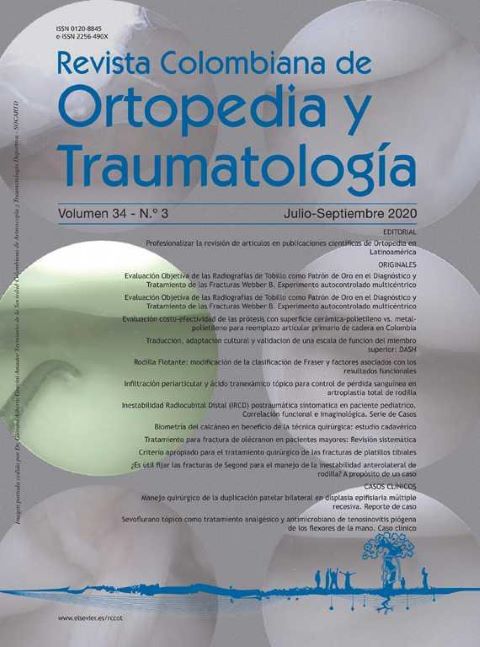Use of Benchmarking for Surgical Treatment of Tibial Plateau Fractures
DOI:
https://doi.org/10.1016/j.rccot.2020.07.003Keywords:
tibial plateau fracture, surgical treatment, prognosis, quality of life, functional score, benchmarkingAbstract
Background: This study presents the use of benchmark criteria for the surgical treatment of tibial plateau fractures. It has 10 elements, including: quality of fracture reduction, fixation stability, time elapsed to fixation, among others. The purpose of the study is to correlate the benchmark criteria used with Rasmussen’s functional score system.
Materials and methods: A retrospective cohort study that included patients with a tibial plateau fracture that required surgical treatment between January 2013 and June 2017. Baseline characteristics, outcomes related with the benchmark criteria, and Rasmussen’s score variables, were registered.
Results: A total of 75 patients were included, with a 6-months minimum follow-up for 89% (n = 67). The median age was 39 years old, and the majority (56.7%) were men. The first cause of fracture was motorcycle accident (67%). There was compromise of a posterior column in 78% of the cases. Treatment was considered appropriate in 61%, and 89% had a good/excellent result in Rasmussen’s functional score. There was a significant linear correlation between the benchmark criteria and Rasmussen’s score, with a Pearson correlation coefficient of 0.6279 (P< .001).
Discussion: Benchmarking criteria may be useful in the evaluation and planning of surgical treatment of tibial plateau fractures. They are associated with better functional results and satisfaction in the Rasmussen’s score.
Level of evidence: II
Downloads
References
Lowe JA, Tejwani N, Yoo B, Wolinsky P. Surgical techniques for complex proximal tibial fractures. J Bone Joint Surg Am. 2011;93:1548-59.
Hall JA, Beuerlein MJ, McKee MD. Canadian Orthopaedic Trauma Society. Open reduction and internal fixation compared with circular fixator application for bicondylar tibial plateau fractures. Surgical technique. J Bone Joint Surg Am. 2009;1 91 Suppl 2 Pt:74-88.
Johnson EE, Timon S, Osuji C. Surgical Technique: TscherneJohnson extensile approach for tibial plateau fractures. Clin Orthop Relat Res. 2013;471:2760-7.
Martínez-Rondanelli A, Escobar-González SS, Henao-Alzate A, Martínez-Cano JP. Reliability of a four-column classification for tibial plateau fractures. Int Orthop. 2017;41:1881-6.
Molenaars RJ, Mellema JJ, Doornberg JN, Kloen P. Tibial Plateau Fracture Characteristics: Computed Tomography Mapping of Lateral, Medial, and Bicondylar Fractures. J Bone Joint Surg Am. 2015;97:1512-20.
Luo CF, Sun H, Zhang B, Zeng BF. Three-column fixation for complex tibial plateau fractures. J Orthop Trauma. 2010;24:683-92.
Quinn RH, Mooar PA, Murray JN, Pezold R, Sevarino KS. Treatment of Hip Fractures in the Elderly. J Am Acad Orthop Surg. 2017;25:e102-4.
Rasmussen PS. Tibial condylar fractures. Impairment of knee joint stability as an indication for surgical treatment. J Bone Joint Surg Am. 1973;55:1331-50.
Postel M, Mazas F, de la Caffinière JY. Posterior fractureseparation of the tibial plateaux. Rev Chir Orthop Reparatrice Appar Mot. 1974;60 Suppl 20:317-23.
Martínez A, Cayón M. Fractura del Platillo Tibial Postero medial. Rev Colomb Ortop Traumatol. 1999;13:37-41.
Yang G, Zhai Q, Zhu Y, Sun H, Putnis S, Luo C. The incidence of posterior tibial plateau fracture: an investigation of 525 fractures by using a CT-based classification system. Arch Orthop Trauma Surg. 2013;133:929-34.
Gicquel T, Najihi N, Vendeuvre T, Teyssedou S, Gayet LE, Huten D. Tibial plateau fractures: reproducibility of three classifications (Schatzker, AO, Duparc) and a revised Duparc classification. Orthop Traumatol Surg Res. 2013;99:805-16.
Zeltzer DW, Leopold SS. Classification in brief: Schatzker classification of tibial plateau fractures. Clin Orthop Relat Res. 2013;471:371-4.
Sohn HS, Yoon YC, Cho JW, Cho WT, Oh CW, Oh JK. Incidence and fracture morphology of posterolateral fragments in lateral and bicondylar tibial plateau fractures. J Orthop Trauma. 2015;29:91-7.
Duparc J, Ficat P. Articular fractures of the upper end of the tibia. Rev Chir Orthop Reparatrice Appar Mot. 1960;46:399-486.
Schatzker J, McBroom R, Bruce D. The tibial plateau fracture. The Toronto experience 1968–1975. Clin Orthop Relat Res. 1979:94-104.
Barei DP, O’Mara TJ, Taitsman LA, Dunbar RP, Nork SE. Frequency and fracture morphology of the posteromedial fragment in bicondylar tibial plateau fracture patterns. J Orthop Trauma. 2008;22:176-82. 288 A. Martínez-Rondanelli et al.
Carlson DA. Bicondylar fracture of the posterior aspect of the tibial plateau. A case report and a modified operative approach. J Bone Joint Surg Am. 1998;80:1049-52.
Bhattacharyya T, McCarty LP, 3rd, Harris MB, Morrison SM, Wixted JJ, Vrahas MS, Smith RM. The posterior shearing tibial plateau fracture: treatment and results via a posterior approach. J Orthop Trauma. 2005;19:305-10.
Doornberg JN, Rademakers MV, van den Bekerom MP, Kerkhoffs GM, Ahn J, Steller EP, Kloen P. Two-dimensional and three-dimensional computed tomography for the classification and characterisation of tibial plateau fractures. Injury. 2011;42:1416-25.
Hu YL, Ye FG, Ji AY, Qiao GX, Liu HF. Three-dimensional computed tomography imaging increases the reliability of classification systems for tibial plateau fractures. Injury. 2009;40:1282-5.
Maroto MD, Scolaro JA, Henley MB, Dunbar RP. Management and incidence of tibial tubercle fractures in bicondylar fractures of the tibial plateau. Bone Joint J. 2013;95-B:1697-702.
Downloads
Published
How to Cite
Issue
Section

| Article metrics | |
|---|---|
| Abstract views | |
| Galley vies | |
| PDF Views | |
| HTML views | |
| Other views | |





